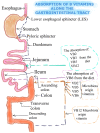B Vitamins, Glucoronolactone and the Immune System: Bioavailability, Doses and Efficiency
- PMID: 38201854
- PMCID: PMC10780850
- DOI: 10.3390/nu16010024
B Vitamins, Glucoronolactone and the Immune System: Bioavailability, Doses and Efficiency
Abstract
The present review deals with two main ingredients of energy/power drinks: B vitamins and glucuronolactone and their possible effect on the immune system. There is a strong relationship between the recommended daily dose of selected B vitamins and a functional immune system. Regarding specific B vitamins: (1) Riboflavin is necessary for the optimization of reactive oxygen species (ROS) in the fight against bacterial infections caused by Staphylococcus aureus and Listeria monocytogenes. (2) Niacin administered within normal doses to obese rats can change the phenotype of skeletal fibers, and thereby affect muscle metabolism. This metabolic phenotype induced by niacin treatment is also confirmed by stimulation of the expression of genes involved in the metabolism of free fatty acids (FFAs) and oxidative phosphorylation at this level. (3) Vitamin B5 effects depend primarily on the dose, thus large doses can cause diarrhea or functional disorders of the digestive tract whereas normal levels are effective in wound healing, liver detoxification, and joint health support. (4) High vitamin B6 concentrations (>2000 mg per day) have been shown to exert a significant negative impact on the dorsal root ganglia. Whereas, at doses of approximately 70 ng/mL, sensory symptoms were reported in 80% of cases. (5) Chronic increases in vitamin B12 have been associated with the increased incidence of solid cancers. Additionally, glucuronolactone, whose effects are not well known, represents a controversial compound. (6) Supplementing with D-glucarates, such as glucuronolactone, may help the body's natural defense system function better to inhibit different tumor promoters and carcinogens and their consequences. Cumulatively, the present review aims to evaluate the relationship between the selected B vitamins group, glucuronolactone, and the immune system and their associations to bioavailability, doses, and efficiency.
Keywords: B vitamins; bioavailability; cobalamin; glucuronolactone; immune system; niacin; riboflavin.
Conflict of interest statement
The authors declare no conflict of interest.
Figures




Similar articles
-
Associations of dietary B vitamins intakes with depression in adults.Int J Vitam Nutr Res. 2023 Apr;93(2):142-153. doi: 10.1024/0300-9831/a000720. Epub 2021 Jul 8. Int J Vitam Nutr Res. 2023. PMID: 34233510
-
Particle length of silages affects apparent ruminal synthesis of B vitamins in lactating dairy cows.J Dairy Sci. 2016 Aug;99(8):6229-6236. doi: 10.3168/jds.2016-11274. Epub 2016 May 26. J Dairy Sci. 2016. PMID: 27236755 Clinical Trial.
-
Apparent ruminal synthesis of B vitamins in lactating dairy cows fed diets with different forage-to-concentrate ratios.J Dairy Sci. 2017 Mar;100(3):1914-1922. doi: 10.3168/jds.2016-12111. Epub 2017 Jan 18. J Dairy Sci. 2017. PMID: 28109593
-
Hydrosoluble vitamins.Handb Clin Neurol. 2014;120:891-914. doi: 10.1016/B978-0-7020-4087-0.00059-0. Handb Clin Neurol. 2014. PMID: 24365359 Review.
-
B Vitamins and Their Role in Immune Regulation and Cancer.Nutrients. 2020 Nov 4;12(11):3380. doi: 10.3390/nu12113380. Nutrients. 2020. PMID: 33158037 Free PMC article. Review.
Cited by
-
Vitamin B5 and vitamin U review: justification of combined use for the treatment of mucosa-associated gastrointestinal pathologies.Front Pharmacol. 2025 May 21;16:1587627. doi: 10.3389/fphar.2025.1587627. eCollection 2025. Front Pharmacol. 2025. PMID: 40469981 Free PMC article. Review.
-
The immunomodulatory effects of vitamins in cancer.Front Immunol. 2024 Oct 7;15:1464329. doi: 10.3389/fimmu.2024.1464329. eCollection 2024. Front Immunol. 2024. PMID: 39434876 Free PMC article. Review.
-
Antioxidant Capacity and Disease Resistance Enhanced by Dietary D-Glucuronolactone Supplementation in Chinese Soft-Shelled Turtles (Pelodiscus sinensis).Antioxidants (Basel). 2025 Apr 29;14(5):534. doi: 10.3390/antiox14050534. Antioxidants (Basel). 2025. PMID: 40427416 Free PMC article.
-
The Review on Adverse Effects of Energy Drinks and Their Potential Drug Interactions.Nutrients. 2025 Jul 25;17(15):2435. doi: 10.3390/nu17152435. Nutrients. 2025. PMID: 40806020 Free PMC article. Review.
-
Immunomodulatory Effects of Selected Non-Nutritive Bioactive Compounds and Their Role in Optimal Nutrition.Curr Issues Mol Biol. 2025 Jan 31;47(2):89. doi: 10.3390/cimb47020089. Curr Issues Mol Biol. 2025. PMID: 39996810 Free PMC article. Review.
References
-
- Um E.R., Plass J.L., Hayward E.O., Homer B.D. Emotional design in multimedia learning. J. Educ. Psychol. 2012;104:485–498. doi: 10.1037/a0026609. - DOI
Publication types
MeSH terms
Substances
LinkOut - more resources
Full Text Sources
Medical

